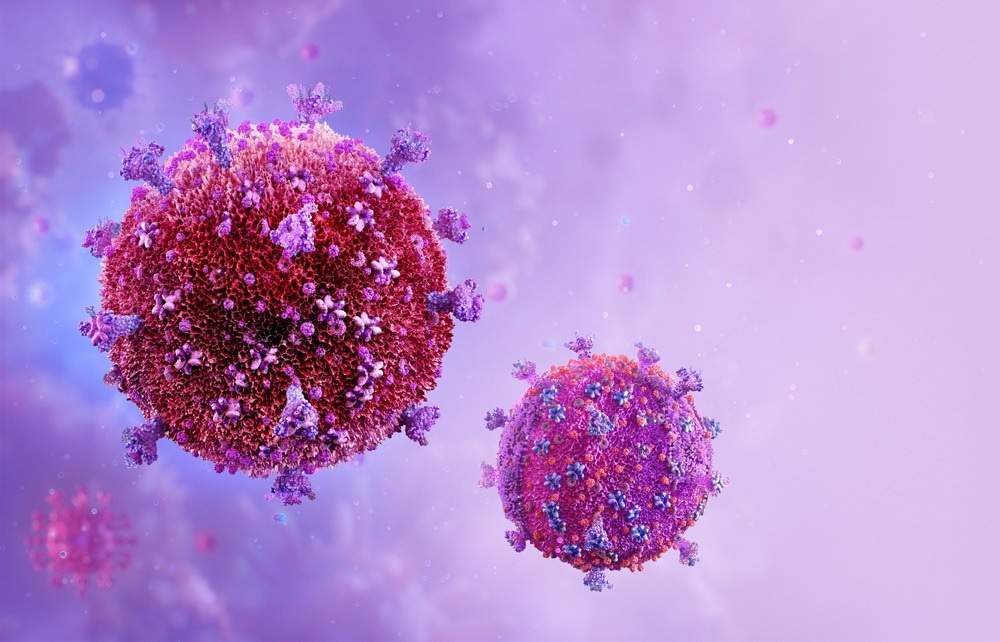In a recent study published in Retrovirology, researchers assessed the effectiveness of severe acute respiratory syndrome coronavirus (SARS-CoV) and SARS-CoV-2 envelope (E) proteins against human immunodeficiency virus (HIV)-1.
 Study: The envelope proteins from SARS-CoV-2 and SARS-CoV potently reduce the infectivity of human immunodeficiency virus type 1 (HIV-1). Image Credit: Corona Borealis Studio/Shutterstock
Study: The envelope proteins from SARS-CoV-2 and SARS-CoV potently reduce the infectivity of human immunodeficiency virus type 1 (HIV-1). Image Credit: Corona Borealis Studio/Shutterstock
Background
Viroporins are ion channels expressed by viruses that play a role in viral assembly and release. Viroporins are encoded by HIV-1 as well as the influenza A virus. The human SARS-CoV-2 encodes for a minimum of two viroporins, including a transmembrane protein with 75 amino acids called the envelope (E) protein and a protein with 275 amino acids called open-reading frame (Orf)-3a.
About the study
In the present study, researchers evaluated HIV-1 replication in the presence of four distinct ꞵ-CoV E proteins.
First, the intracellular expression corresponding to the SARS-CoV-2 E protein was investigated. The team transfected COS-7 cells with a vector encoding the SARS-CoV-2 E protein fused to a hemagglutinin (HA)-tag at the C-terminus and immunostained to detect E protein (anti-HA) while antibodies were directed against the endoplasmic reticulum-Golgi intermediate compartment (ERGIC53), trans Golgi (Golgin97), or late endosomes/lysosomes (LAMP-1).
To examine E protein co-localization with the ER, trans-Golgi network (TGN) and cis-medial Golgi, cells were co-transfected along with plasmids that expressed the E-HA protein with vectors that expressed ER-Mox-green fluorescent protein (GFP) (RER), giantin-GFP, or TGN. During these co-transfections, the team fixed, permeabilized, and immunostained the cells with anti-HA antibody to detect the E protein.
The intracellular distribution of SARS-CoV-2 E was also compared to the E proteins present in SARS-CoV, human CoV (hCoV)-OC43, and Middle East respiratory syndrome (MERS)-CoV. Next, the team determined whether the SARS-CoV-2 E protein would increase or decrease the production of infectious ΔvpuHIV-1 or HIV-1.
HEK293 cells were co-transfected with pcDNA3.1(+) that expressed the SARS-CoV-2 E protein along with HSV-1 glycoprotein D (gD), which served as the positive control for restriction, or gD[ΔTMCT], and pNL4-3. Furthermore, the researchers investigated whether the E protein inhibited ΔvpuHIV-1. The capacity of ΔvpuHIV-1 to multiply in the presence of SARS-CoV-2 E and bone marrow stromal cell antigen 2 (BST-2) proteins were also determined.
Results
The results indicated that the SARS-CoV-2 E protein was co-localized with ER, ERGIC, trans Golgi, cis-medial Golgi, and TGN markers. However, neither the cell plasma membrane nor the lysosomes contained E protein. The intracellular localization observed for the three E proteins was identical to that of the SARS-CoV-2 E protein. In the presence of the SARS-CoV-2 E protein, the amount of infectious HIV-1 released was dramatically reduced. Immunoblots observed for the SARS-CoV-2 E, and gD proteins on cell lysates demonstrated that these proteins were well expressed during co-transfections.
Co-transfection with vectors that expressed BST-2, SARS-CoV-2 E protein, and the ΔvpuHIV-1 genome resulted in a decline in infectious virus generation, although not to the same extent as the HSV-1 gD protein. Immunoblots for the SARS-CoV-2 E protein, gD, Vpu, and BST-2 on cell lysates demonstrated that these proteins were effectively expressed during co-transfections. Collectively, this demonstrated that the SARS-CoV-2 E protein hindered the generation of both viruses and could not replace the Vpu protein.
Similar to the SARS-CoV-2 E protein, investigation of the intracellular expression of the HcoV-OC43, SARS-CoV, and MERS-CoV E proteins indicated that they were mostly localized in the ER and Golgi sections of the cell, with no expression observed at the cell surface. Whi gD inhibited the infectious HIV-1 release, gD [ΔTMCT] showed no such impact. Furthermore, the SARS-CoV and SARS-CoV-2 E proteins inhibited the release of HIV-1 by 1.4% and 1.3%, respectively.
Immunoprecipitation of HIV-1 proteins from lysates generated from cells co-transfected with the vector encoding SARS-CoV-2 E and pNL4-3 indicated that E precursor, namely gp120, gp160, p24, and p55 were immunoprecipitated at significantly lower quantities than p24 and gp120 in the clarified culture media.
Transfection of HEK293 cells with an empty pcDNA3.1(+) vector and subsequent treatment with STS induced considerable caspase 3 activity. SARS-CoV and SARS-CoV-2 E proteins showed the highest amount of caspase 3 activity, followed by HCoV-OC-43 and MERS-CoV E proteins. These findings demonstrated a link between caspase 3 activity and HIV-1 production levels.
Conclusion
Overall, the study findings demonstrated that although viroporins derived from homologous viruses can increase viral release, a viroporin from a heterologous virus can inhibit HIV-1 protein synthesis and virus release.